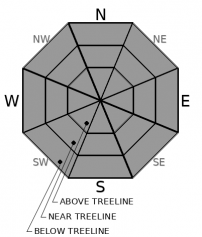| Tuesday | Tuesday Night | Wednesday | |
|---|---|---|---|
| Weather: | Mostly cloudy. Chance of rain and snow. Snow levels 7500 feet. Chance of precipitation is 25%. | Mostly cloudy. Slight chance of rain and snow in the evening. Snow levels 7500 feet. Chance of precipitation is 15%. | Mostly cloudy. Snow levels below 7000 feet increasing to 7500 feet in the afternoon. Chance of precipitation is 10%. |
| Temperatures: | 40 to 45 deg. F. | 23 to 29 deg. F. | 41 to 46 deg. F. |
| Mid Slope Winds: | Light winds. | Light winds. | Light winds. |
| Expected snowfall: | 30% probability up to 1 inch. 70% probability no accumulation. | SWE = less than 0.10 inch. | 30% probability up to 1 inch. 70% probability no accumulation. | SWE = trace amounts. | No accumulation. | SWE = none. |
| Tuesday | Tuesday Night | Wednesday | |
|---|---|---|---|
| Weather: | Mostly cloudy. Chance of snow. Snow levels 7500 feet. Chance of precipitation is 25%. | Mostly cloudy. Slight chance of snow in the evening. Snow levels 7500 feet. Chance of precipitation is 15%. | Mostly cloudy. Snow levels below 7000 feet increasing to 7500 feet in the afternoon. Chance of precipitation is 10%. |
| Temperatures: | 37 to 43 deg. F. | 23 to 28 deg. F. | 37 to 43 deg. F. |
| Ridge Top Winds: | Southwest 15 to 20 mph with gusts to 35 mph. | Light winds. | Light winds. |
| Expected snowfall: | 30% probability up to 1 inch. 70% probability no accumulation. | SWE = less than 0.10 inch. | 30% probability up to 1 inch. 70% probability no accumulation. | SWE = trace amounts. | No accumulation. | SWE = none. |
























